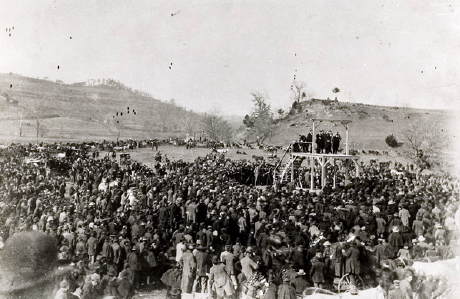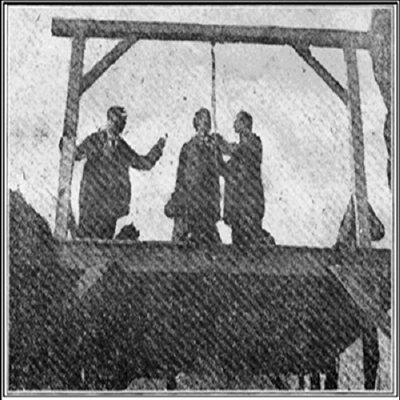1897:SIX THOUSAND ATTEND LAST PUBLIC HANGING AT RIPLEY - 'From Far Away As Calhoun, Two Counties Distant' They Came

The last public hanging in WV at Ripley in 1897 drew a crowd
of nearly 6,000 people, from neighboring counties and Ohio
The scaffold sat on the top of a knoll, the photo was taken before trap was sprung before a crowd of nearly 6,000, the cold winter day not holding them back.
West Virginia's last public hanging was at Ripley, Jackson County on December 16, 1897. John F. Morgan, 27, was convicted by a jury for the murder of three in a family of four persons.
The murder was perhaps the most bloodthirsty in the annals of the state of West Virginia, and attracted nation-wide attention at that time.
Morgan murdered Chloe Greene with a hatchet and two of her young children, with one child escaping the murderer to report the crime.
Scores of newspaper correspondents from different parts of the United States visited Ripley and were present when the hangman's noose snuffed out the life of Morgan.
The Jackson Herald reported that at five to six thousand came to a "county fair" atmosphere, gathering on 10-acre lot, coming "on foot, on horseback, in wagons, up trees, and on fences. Some of them had started from their homes two whole days before from as far away at Calhoun, two counties distant."
The paper said they came to see the "shettin' out" of John F. Morgan.
Reese Blizzard, a practicing attorney in Parkersburg, was the judge of the court which sentenced Morgan to hang. Blizzard was formerly a resident and attorney in Calhoun County.

One of the few pictures in existence of the last
public hanging to take place in West Virginia at Ripley
The photograph (above) was taken by Will Rogers, a reporter for The Parkersburg News. John Morgan, the condemned man, is shown in the center with the noose around his neck, Sheriff J. O. Shinn adjusting the noose, and his brother, Doug Shinn pointing.
"Promptly at 11:34 o'clock Thursday morning, December 16, 1897, the procession left the courthouse in the following order: Deputy Sheriffs Doug Shinn and J. M. Weas, on horseback, followed by a surrey in which were hitched two black horses with Lou Bowman of Spencer holding the reins. Seated by his side were Rev. J. J. White, Rev. T. H. Rymer, and in the back seat were Sheriff J. O. Shinn and the prisoner, John Morgan, cool and collected, who was constantly looking about thru the crowd of people, occasionally nodding his head to friends his eyes fell upon."
"Next came the buggy with Dr. B. E. Harrison and Prosecuting Attorney J. A. Seaman, Then two big wagons filled with newspaper men and the jury, followed by Circuit Court Clerk M. C. Archer, and various other kinds of vehicles, horsemen and people on foot."
"The scaffold was reached in about 15 minutes after a drive of one mile. The spot where the execution was made was an ideal one for such a purpose and had the crowd...six thousand persons saw the hanging.
"As 12 o'clock approached Sheriff Shinn and the prisoner Morgan walked up the steps of the scaffold together with a few others. A scripture reading followed while the condemned man look out over the crowd and seemed least concerned of any present."
"After prayer had been offered by Sheriff Shinn, there was a short conversation with the prisoner, who said: 'I bid you all farewell. I bid you all farewell.' Then he stepped on the trapdoor and said: 'Gentlemen, this is a warning to all young men. Don't do as I have done. God forbid that you ever go astray as I have.'"
"The sheriff then stepped forward and took the handcuffs off, strapped Morgan's arms behind him, also strapped his ankles and above his knees, then adjusted the noose, while Morgan stood erect and cool and said: 'Good-bye, gentleman; farewell to all.'"
"The black cap was put on. The sheriff stepped behind him and adjusted the string and turning quickly pulled the lever that sprung the trap and Morgan was dangling in the air before the people had hardly time to realize what was going on. The sheriff did his work well, without a hitch, and the prisoner's neck was snapped."
"The trap fell at 12:09 and at 12:24 Morgan was pronounced dead by Drs. Harrison and Casto."
"There was not a perceptible move of any part of the body except a quivering of the toes was noticeable."
"He was left hanging about 51 minutes when Sheriff Shinn untied the rope and he was lowered into the hands of Undertaker Robert Vail and assistant John Connelly who made the rude pauper's coffin in which he was afterwards placed and taken back to jail."
"On Friday morning his remains were sent to the home of his wife and were buried on the farm of Hiram Hall, her father, some 12 miles from Ripley."
"And so ends the account of the hanging of John Morgan, which episode is the closing chapter in the annals of West Virginia's public executions."
"Immediately after this hanging the law went into effect that abolished public executions and the next man hanged in the state went to his death on the gallows at his prison."
Hanging was the official method of execution until 1949.
In 1949 West Virginia was the last state to adopt the electric chair. The two first inmates electrocuted were Harry Burdette and Fred Painter. State Delegate Robert Byrd was among the official witnesses during their executions. Byrd recalled this event, stating "It's not a beautiful thing."
Until 1959, 102 people were hanged, nine electrocuted and one hung in chains. No women have been executed in West Virginia.
The last person executed by West Virginia was Elmer Brunner on April 3, 1959.
West Virginia was among the last two states to abolish capital punishment in 1965.